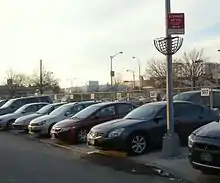Edward Byrne (police officer)
Edward Byrne (February 21, 1966 – February 26, 1988) was a police officer in the New York City Police Department who became well known in the United States after he was murdered in the line of duty.
Edward Byrne | |
|---|---|
| Born | February 21, 1966 New York City, New York, United States |
| Died | February 26, 1988 (aged 22) |
| Police career | |
| Department | New York City Police Department (NYPD) |
| Service years | 1986 - 1988 |
| Rank | 1986 - Commissioned as a Police Officer |
| Badge no. | 14072 |
Byrne's father had also been an NYPD officer. Byrne had joined the NYPD on July 15, 1986 and was stationed in the 103rd Precinct in Jamaica, Queens. Prior to joining the NYPD, Byrne was in the New York City Transit Police.
Murder
Around 3:30 a.m on February 26, 1988, Byrne was sitting in his marked patrol car on 107th Avenue and Inwood Street in South Jamaica, Queens. He was assigned to keep an eye on the house of the local Guyanese immigrant Arjune, who had repeatedly called the police to report on illegal activities on his street. The house had been previously firebombed on two separate occasions and the owner repeatedly threatened. Despite the recent violence and an ongoing crime wave overtaking South Queens, Byrne was assigned to the post alone.
As Byrne sat in his car another car pulled up beside him. Two men exited, and one of them knocked on the passenger side window of Byrne's cruiser while a second man crept up on the driver's side and shot Byrne in the head five times with a .38 caliber pistol. Two other men acted as lookouts. Byrne later died at the hospital. He had just turned 22.[1]
The murder prompted nationwide outrage. US President Ronald Reagan personally called the Byrne family to offer condolences.[2] George H. W. Bush carried Byrne's badge with him on his campaign for president in 1988.[3]
The four killers were identified as Philip Copeland, Todd Scott, Scott Cobb, and David McClary.[4] All four were apprehended within a week of the murder and were eventually convicted. Copeland, Scott, and Cobb were convicted after a trial of murder in the second degree and criminal possession of a weapon in the second degree. McClary was convicted later as the shooter in a separate trial of murder in the second degree and criminal possession of a weapon in the second degree. All four were sentenced to 25 years to life by Queens Supreme Court Justice Thomas A. Demakos, who had presided over the trials.[5] Cobb, in a videotaped confession that was played at trial, provided graphic details of the killing, told how the participants had bragged of it afterward in the aftermath, and indicated that the killing had been ordered from jail by the drug dealer Howard "Pappy" Mason,[6] the leader of their gang. Mason was sentenced to life in prison in 1994 for drug racketeering and for ordering Byrne's murder.[7]

Legacy
- In honor of Police Officer Edward Byrne, 91st Avenue was renamed P.O. Edward R. Byrne Avenue.[8]
- Pol. Officer Edward Byrne Park in Queens was dedicated on August 3, 1995.[9]
- Junior High School 101 in the Bronx was renamed in his honor.
- The Police Athletic League of New York City renamed its Queens Center the Edward R. Byrne Institute and fills it year-round with quality educational and recreational programs.
- The U.S. Department of Justice established the Edward Byrne Memorial Justice Assistance Grant Program, which directs funding to local law enforcement agencies with the primary aim to enhance officer safety via equipment, technology, and training.
- The baseball field at his alma mater, Plainedge High School in North Massapequa, New York, is named in his honor.[10]
References
- Marzulli, John (24 February 2008). "20 yrs. ago, a cop was shot & NYPD began crushing drug gangs". New York Daily News. Retrieved 8 May 2015.
- Messing, Philip (18 November 2014). "Killers who shot rookie cop 26 years ago denied parole". New York Post. Retrieved 8 May 2015.
- Brown, Ethan (2007). Snitch: Informants, Cooperators and the Corruption of Justice. PublicAffairs. p. 32. ISBN 9781586486334.
- Harshbager, Rebecca (3 September 2012). "NYPD cop killers haven't shown remorse for 1988 death, relatives and politicians say". New York Post. Retrieved 8 May 2015.
- Fried, Joseph P. (30 March 1989). "2 Juries Convict All 3 Defendants In Queens Murder of Officer Byrne". The New York Times. Retrieved 8 May 2015.
- Fried, Joseph P. (14 October 1988). "Officer's Killing 'a Message to Police'". The New York Times. Retrieved 8 May 2015.
- Fried, Joseph P. (1994-01-09). "Drug Dealer Is Sentenced to Life For Ordering Killing of Officer". The New York Times. ISSN 0362-4331. Retrieved 2020-02-26.
- Philbin, Tom (2011). The Killer Book of Infamous Murders. Sourcebooks. p. 29. ISBN 9781402237461.
- "Police Officer Edward Byrne Park". nycgovparks.org.
- Nolan, Caitlin (7 May 2015). "Long Island high school baseball team honors fallen NYPD cop Brian Moore". New York Daily News. Retrieved 10 May 2015.